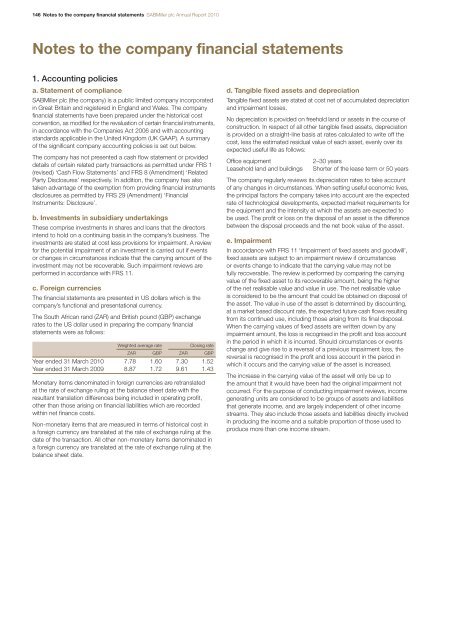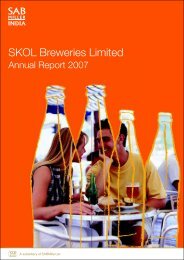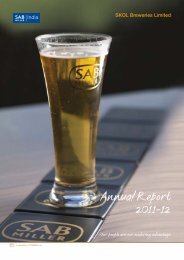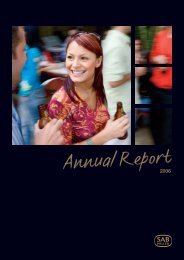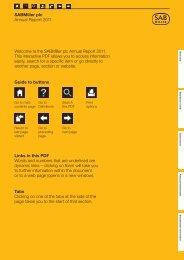Annual Report - SABMiller
Annual Report - SABMiller
Annual Report - SABMiller
- No tags were found...
You also want an ePaper? Increase the reach of your titles
YUMPU automatically turns print PDFs into web optimized ePapers that Google loves.
146 Notes to the company financial statements <strong>SABMiller</strong> plc <strong>Annual</strong> <strong>Report</strong> 2010Notes to the company financial statements1. Accounting policiesa. Statement of compliance<strong>SABMiller</strong> plc (the company) is a public limited company incorporatedin Great Britain and registered in England and Wales. The companyfinancial statements have been prepared under the historical costconvention, as modified for the revaluation of certain financial instruments,in accordance with the Companies Act 2006 and with accountingstandards applicable in the United Kingdom (UK GAAP). A summaryof the significant company accounting policies is set out below.The company has not presented a cash flow statement or provideddetails of certain related party transactions as permitted under FRS 1(revised) ‘Cash Flow Statements’ and FRS 8 (Amendment) ‘RelatedParty Disclosures’ respectively. In addition, the company has alsotaken advantage of the exemption from providing financial instrumentsdisclosures as permitted by FRS 29 (Amendment) ‘FinancialInstruments: Disclosure’.b. Investments in subsidiary undertakingsThese comprise investments in shares and loans that the directorsintend to hold on a continuing basis in the company’s business. Theinvestments are stated at cost less provisions for impairment. A reviewfor the potential impairment of an investment is carried out if eventsor changes in circumstances indicate that the carrying amount of theinvestment may not be recoverable. Such impairment reviews areperformed in accordance with FRS 11.c. Foreign currenciesThe financial statements are presented in US dollars which is thecompany’s functional and presentational currency.The South African rand (ZAR) and British pound (GBP) exchangerates to the US dollar used in preparing the company financialstatements were as follows:Weighted average rateClosing rateZAR GBP ZAR GBPYear ended 31 March 2010 7.78 1.60 7.30 1.52Year ended 31 March 2009 8.87 1.72 9.61 1.43Monetary items denominated in foreign currencies are retranslatedat the rate of exchange ruling at the balance sheet date with theresultant translation differences being included in operating profit,other than those arising on financial liabilities which are recordedwithin net finance costs.Non-monetary items that are measured in terms of historical cost ina foreign currency are translated at the rate of exchange ruling at thedate of the transaction. All other non-monetary items denominated ina foreign currency are translated at the rate of exchange ruling at thebalance sheet date.d. Tangible fixed assets and depreciationTangible fixed assets are stated at cost net of accumulated depreciationand impairment losses.No depreciation is provided on freehold land or assets in the course ofconstruction. In respect of all other tangible fixed assets, depreciationis provided on a straight-line basis at rates calculated to write off thecost, less the estimated residual value of each asset, evenly over itsexpected useful life as follows:Office equipment2–30 yearsLeasehold land and buildings Shorter of the lease term or 50 yearsThe company regularly reviews its depreciation rates to take accountof any changes in circumstances. When setting useful economic lives,the principal factors the company takes into account are the expectedrate of technological developments, expected market requirements forthe equipment and the intensity at which the assets are expected tobe used. The profit or loss on the disposal of an asset is the differencebetween the disposal proceeds and the net book value of the asset.e. ImpairmentIn accordance with FRS 11 ‘Impairment of fixed assets and goodwill’,fixed assets are subject to an impairment review if circumstancesor events change to indicate that the carrying value may not befully recoverable. The review is performed by comparing the carryingvalue of the fixed asset to its recoverable amount, being the higherof the net realisable value and value in use. The net realisable valueis considered to be the amount that could be obtained on disposal ofthe asset. The value in use of the asset is determined by discounting,at a market based discount rate, the expected future cash flows resultingfrom its continued use, including those arising from its final disposal.When the carrying values of fixed assets are written down by anyimpairment amount, the loss is recognised in the profit and loss accountin the period in which it is incurred. Should circumstances or eventschange and give rise to a reversal of a previous impairment loss, thereversal is recognised in the profit and loss account in the period inwhich it occurs and the carrying value of the asset is increased.The increase in the carrying value of the asset will only be up tothe amount that it would have been had the original impairment notoccurred. For the purpose of conducting impairment reviews, incomegenerating units are considered to be groups of assets and liabilitiesthat generate income, and are largely independent of other incomestreams. They also include those assets and liabilities directly involvedin producing the income and a suitable proportion of those used toproduce more than one income stream.


